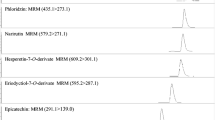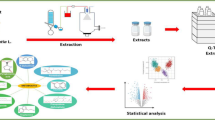Abstract
The aim of the study was to screen the metabolite profile of phalsa (Grewia asiatica), an underutilized fruit crop, using liquid chromatography-high resolution mass spectrometric analysis. A total of 50 compounds were tentatively identified based on their molecular mass and characteristic fragment ions, each with less than 5 ppm of mass error. These compounds included 21 flavonols, 2 dihydroflavonols, 7 flavones, 3 flavanols, 6 anthocyanins, 3 isoflavonoids, 2 phenolic acids, 2 flavanones, and 4 other phenolics. Flavonols were the predominant group of compounds, representing around 52.6% of the total phenolics. The paper has also discussed the potentiality of phalsa as an emerging functional food for the management of various human diseases in relation to the existing literature.


Similar content being viewed by others
References
Agarwal S, Mishra K (1979) New flavonoids from the Grewia asiatica. J Ind Chem Soc 56(6):649
Asghar MN, Khan IU, Sherin L, Ashfaq M (2008) Evaluation of antioxidant activity of Grewia asiatica berry using 2,2-azinobis-(3-ethylbenzoline-6-sulphonic acid) and N, N-dimethyl-p-phenylenediamine radical cations decolourazation assays. Asian J Chem 20:5123–5132
Azuma K, Masayoshi N, Masaji K, Katsunari I, Yuichi Y, Katsunari K, Yuji Y, Hidekazu I, Hisao H (1999) Phenolic antioxidants from the leaves of Corchorus olitorius L. J Agric Food Chem 47:3963–3966
Cheynier V, Comte G, Davies KM, Lattanzio V, Martens S (2013) Plant phenolics: recent advances on their biosynthesis, genetics, and ecophysiology. Plant Physiol Biochem 72:1–20
Das D, Mitra A, Datta D, Saha A, Hazra J (2012) Evaluation of antipyretic and analgesic activity of parusaka (Grewia asiatica Linn.): an indigenous Indian plant. Int J Res Ayur Pharm 3:519–524
Fang J, Zhou Q, Shi XL, Jiang BH (2007) Luteolin inhibits insulin-like growth factor 1 receptor signaling in prostate cancer cells. Carcinogenesis 28:713–723
Fang XK, Gao J, Zhu DN (2008) Kaempferol and quercetin isolated from Euonymus alatus improve glucose uptake of 3T3-L1 cells without adipogenesis activity. Life Sci 82:615–622
Hämäläinen M, Nieminen R, Vuorela P, Heinonen M, Moilanen E (2007) Anti-inflammatory effects of flavonoids: genistein, kaempferol, quercetin, and daidzein inhibit STAT-1 and NF-κB activations, whereas flavone, isorhamnetin, naringenin, and pelargonidin inhibit only NF-κB activation along with their inhibitory effect on iNOS expression and NO production in activated macrophages. Mediat Inflamm. https://doi.org/10.1155/2007/45673
Iwashina T, Kokubugata G (2012) Flavone and flavonol glycosides from the leaves of Triumfetta procumbens in Ryukyu Islands. Bull Natl Mus Nat Sci 38:63–67
Jin UH, Lee JY, Kang SK, Kim JK, Park WH, Kim JG, Moon SK, Kim CH (2005) A phenolic compound, 5-caffeoylquinic acid (chlorogenic acid), is a new type and strong matrix metalloproteinase-9 inhibitor: isolation and identification from methanol extract of Euonymus alatus. Life Sci 77:2760–2769
Khan MSY, Javed K, Khan MH, Shamsi MA, Siddiqui AA (1991) α-amyrin derivatives from Corchorus depressus. Phytochem 30:1989–1992
Khan RS, Asghar W, Khalid N, Nazir W, Farooq M, Ahmed I, Syed QA (2019) Phalsa (Grewia asiatica L) fruit berry a promising functional food ingredient: a comprehensive review. J Berry Res 9(2):179–193
Khattab HA, El-Shitany NA, Abdallah IZ, Yousef FM, Alkreathy HM (2015) Antihyperglycemic potential of Grewia asiatica fruit extract against streptozotocin-induced hyperglycemia in rats: anti-inflammatory and antioxidant mechanisms. Oxid Med Cell Longev 2015:549743–549750
Khurdiya DS, Anand JC (1981) Anthocyanin derivatives from the fruits of Grewia asiatica. J Food Sci Technol 18:112–114
Kirtikar KR, Basu BD (1989) Indian medicinal plants, vol I, 2nd edn. Lalit Mohan Basu, Allahabad
Lancaster JE, Grant JE, Lister CE, Taylor MC (1994) Skin color in apples—influence of copigmentation and plastid pigments on shade and darkness of red color in five genotypes. J Am Soc Hortic Sci 119:63–69
Lee J, Choi JW, Sohng JK, Pandey RP, Park YI (2016) The immunostimulating activity of quercetin 3-O-xyloside in murine macrophages via activation of the ASK1/MAPK/NF-κB signaling pathway. Int Immunopharmacol 31:88–97
Lim TK (2012) Grewia asiatica. In: Lim TK (ed) Edible medicinal and non medicinal plants. Springer Inc., Netherlands, pp 184–188
Lin CM, Huang ST, Liang YC, Lin MS, Shih CM, Chang YC, Chen TY, Chen CT (2005) Isovitexin suppresses lipopolysaccharide-mediated inducible nitric oxide synthase through inhibition of NF-kappa B in mouse macrophages. Planta Med 71:748–753
Marya B, Dattani KH, Patel DD, Patel PD, Patel D, Suthar MP, Patel VP, Bothara SB (2011) In vitro cytotoxicity evaluation of aqueous fruit and leaf extracts of Grewia asiatica using MTT assay. Pharm Chem 3:282–287
Ojeda D, Jiménez-Ferrer E, Zamilpa A, Herrera-Arellano A, Tortoriello J, Alvarez L (2010) Inhibition of angiotensin convertin enzyme (ACE) activity by the anthocyanins delphinidin and cyanidin-3-O-sambubiosides from Hibiscus sabdariffa. J Ethnopharmacol 127:7–10
Park JB (2009) 5-Caffeoylquinic acid and caffeic acid orally administered suppress P-selectin expression on mouse platelets. J Nutr Biochem 20:800–805
Paul S (2015) Pharmacological actions and potential uses of Grewia asiatica: a review. Int J App Res 1(9):222–228
Rithidech KN, Tungjai M, Whorton EB (2005) Protective effect of apigenin on radiation-induced chromosomal damage in human lymphocytes. Mutat Res, Genet Toxicol Environ Mutagen 585:96–104
Sharma A, Gupta P (2013) Evaluation of antioxidant activity and validated method for analysis of polyphenols from non-edible parts of Indian tropical fruits by using microwave assisted extraction and LC–MS/MS. Int J Pharm Biol Sci 4:227–241
Sharma KV, Sisodia R (2009) Evaluation of the free radical scavenging activity and radioprotective efficacy of Grewia asiatica fruit. J Radiol Prot 29:429
Sharma KV, Sisodia R (2010) Hepatoprotective efficacy of Grewia asiatica fruit against oxidative stress in Swiss albino mice. Iran J Radiat Res 8:75–85
Siddiqi R, Naz S, Ahmad S, Sayeed SA (2011) Antimicrobial activity of the polyphenolic fractions derived from Grewia asiatica, Eugenia jambolana and Carissa carandas. Int J Food Sci Technol 46:250–256
Talpur MK, Talpur FN, Balouch A, Nizamani SM, Surhio MA (2017) Analysis and characterization of anthocyanin from phalsa (Grewia asiatica). MOJ Food Process Technol 5(3):00127. https://doi.org/10.15406/mojfpt.2017.05.00127
Taskeen A, Naeem I, Bakhtawar S, Mehmood T (2010) A comparative study of flavonoids in fruits and vegetables with their products using reverse phase high performance liquid chromatography (RP-HPLC). Electron J Environ Agric Food Chem 9:1372–1377
Ueda H, Yamazaki C, Yamazaki M (2002) Luteolin as an anti-inflammatory and anti-allergic constituent of Perilla frutescens. Biol Pharm Bull 25:1197–1202
Vazquez-Prieto MA, Bettaieb A, Rodriguez Lanzi C, Soto VC, Perdicaro DJ, Galmarini CR, Haj FG, Miatello RM, Oteiza PI (2015) Catechin and quercetin attenuate adipose inflammation in fructose-fed rats and 3T3-L1 adipocytes. Mol Nutr Food Res 59:622–633
Wang SJ, Tong Y, Lu S, Yang R, Liao X, Xu YF, Li X (2010) Anti-inflammatory activity of myricetin isolated from Myrica rubra Sieb. et Zucc. leaves. Planta Med 76:1492–1496
Wang Y, Tang C, Zhang H (2015) Hepatoprotective effects of kaempferol 3-O-rutinoside and kaempferol 3-O-glucoside from Carthamus tinctorius L. on CCl4-induced oxidative liver injury in mice. J Food Drug Anal 23:310–317
Zhou M, Ren H, Han J, Wang W, Zheng Q, Wang D (2015) Protective effects of kaempferol against myocardial ischemia/reperfusion injury in isolated rat heart via antioxidant activity and inhibition of glycogen synthase kinase-3. Oxid Med Cell Longev. https://doi.org/10.1155/2015/481405
Author information
Authors and Affiliations
Corresponding author
Ethics declarations
Conflicts of interest
The authors declare that they do not have any conflict of interest.
Additional information
Publisher's Note
Springer Nature remains neutral with regard to jurisdictional claims in published maps and institutional affiliations.
Electronic supplementary material
Below is the link to the electronic supplementary material.
Rights and permissions
About this article
Cite this article
Koley, T.K., Khan, Z., Oulkar, D. et al. Profiling of polyphenols in phalsa (Grewia asiatica L) fruits based on liquid chromatography high resolution mass spectrometry. J Food Sci Technol 57, 606–616 (2020). https://doi.org/10.1007/s13197-019-04092-y
Revised:
Accepted:
Published:
Issue Date:
DOI: https://doi.org/10.1007/s13197-019-04092-y




